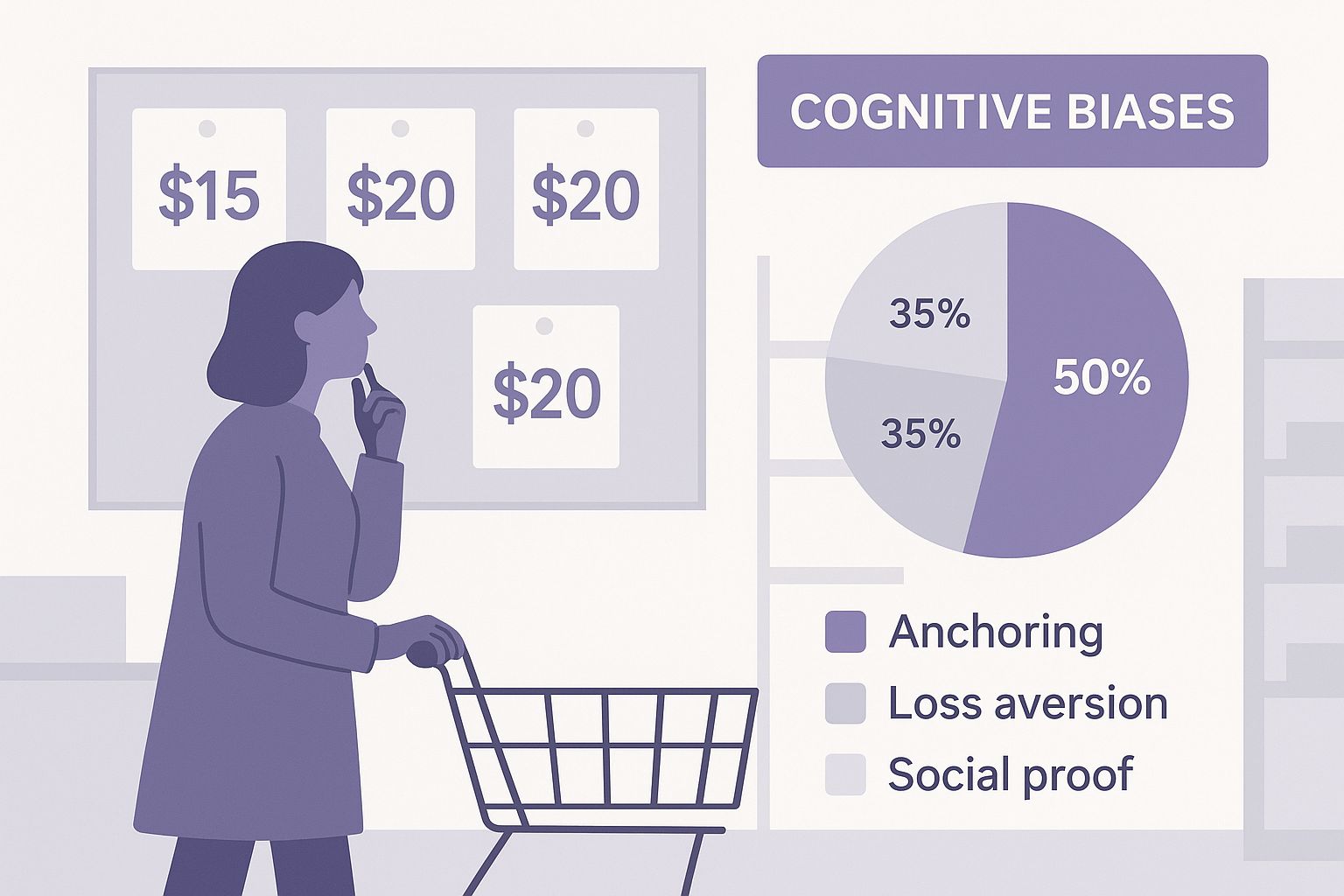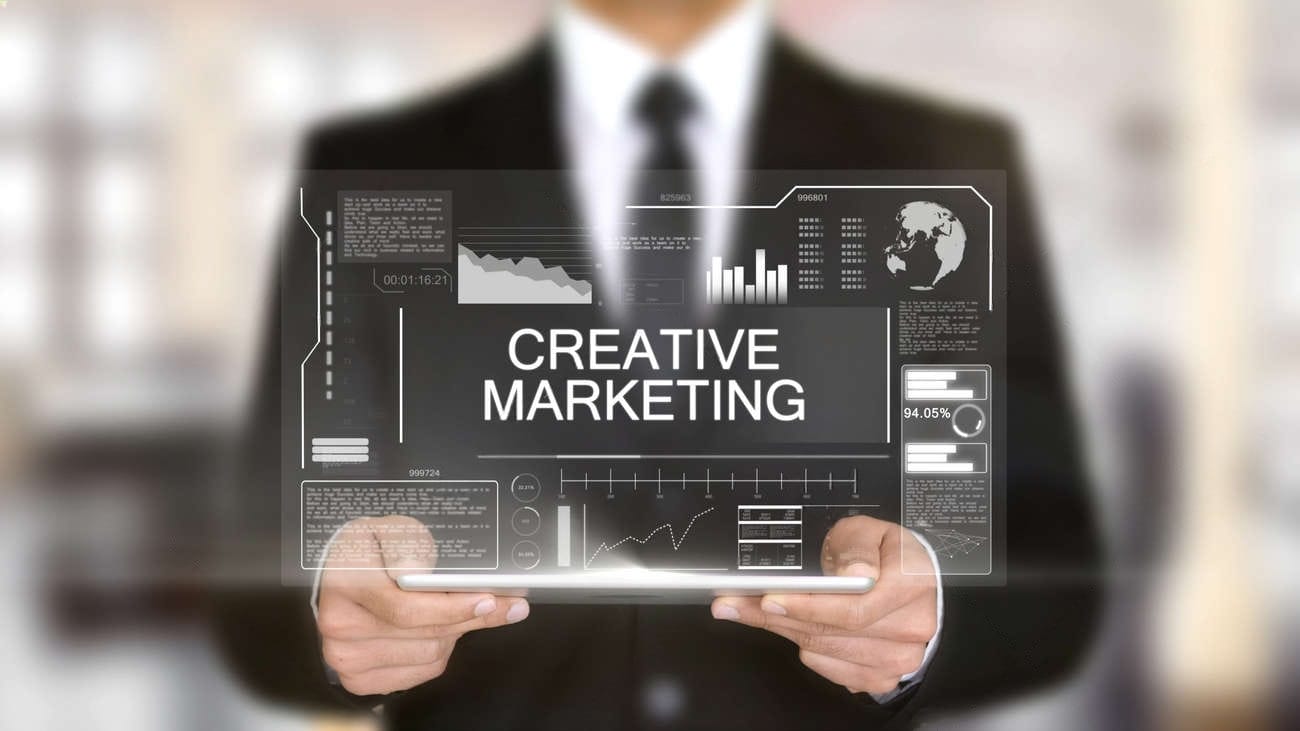The Psychology Behind Purchase Decisions
Traditional marketing often assumes consumers are rational, weighing pros and cons before buying. However, behavioral economics reveals our decisions are often driven by emotions, cognitive biases, and subconscious influences. Understanding this psychology is crucial for effective marketing. Forward-thinking brands are ditching outdated models and embracing the complexities of human behavior for a competitive edge.
Emotional triggers often outweigh logic. Think about your last impulse buy. Was it pure logic, or were you swayed by a feeling, a desire, or social influence? Heuristics, or cognitive shortcuts, also play a significant role in our choices. These mental shortcuts simplify decisions, but can lead to predictable biases. This understanding allows marketers to create campaigns that truly resonate with consumers.
The global behavioral economics market is booming, driven by its applications in consumer behavior analysis and policy-making. The integration of AI and data analytics fuels this growth, allowing businesses to predict purchasing patterns and personalize strategies. Find more detailed statistics here. For example, “nudges,” subtle interventions designed to influence behavior, boost customer engagement in direct marketing. Nudges work by aligning marketing messages with our dual-system decision-making – the interplay of fast, intuitive thinking and slower, deliberative thinking.
Understanding Cognitive Biases
Behavioral economics goes beyond basic psychology, identifying specific cognitive biases affecting consumer behavior. Loss aversion – feeling the pain of a loss more strongly than the pleasure of an equivalent gain – explains the effectiveness of limited-time offers.
Anchoring, relying heavily on the first piece of information received (“the anchor”), explains why premium pricing works. It creates a perception of higher value compared to later, possibly still expensive, options. The endowment effect, valuing something more simply because you own it, can turn free trials into paid subscriptions.
When measuring the impact of behavioral economics, consider these agency metrics and KPIs. By understanding and applying these biases thoughtfully, marketers create powerfully persuasive campaigns, driving higher conversion rates ethically. It’s crucial to avoid exploiting consumer vulnerabilities. Ultimately, understanding behavioral economics helps marketers connect with their audience authentically, building trust and lasting relationships.
Cognitive Biases That Drive Consumer Behavior
Traditional marketing often assumes consumers make rational choices. However, behavioral economics shows us that cognitive biases play a significant role in our decision-making processes. These biases, which are essentially predictable deviations from rational judgment, offer marketers valuable opportunities to connect with consumers on a deeper level.
Loss Aversion and Scarcity
Loss aversion is the principle that the pain of losing something outweighs the pleasure of gaining something of equal value. This explains the effectiveness of limited-time offers. The fear of missing out (FOMO) motivates consumers to act quickly.
Similarly, scarcity, the perception of limited supply, boosts a product’s perceived value. Marketers often use this by emphasizing “limited-time only” deals or “while supplies last” promotions.
Anchoring and The Endowment Effect
Anchoring describes our tendency to overemphasize the first piece of information we receive (the “anchor”) when making decisions. For instance, if a product’s initial price is high, subsequent discounts seem more attractive, even if the final price is still relatively high.
The endowment effect refers to our tendency to value something more simply because we own it. This is why free trials are effective in converting users to paying customers. The trial period fosters a sense of ownership, making it difficult to give up the product or service.
Social Proof and Choice Architecture
Social proof, our inclination to follow others’ actions, is often used in marketing through testimonials, reviews, and influencer marketing. Seeing others endorse a product builds trust and encourages conformity.
Choice architecture involves presenting options in specific ways to influence decisions. This can include setting a default option, framing choices strategically, or simplifying complex decisions. Behavioral economics has transformed direct marketing with tactics like choice architecture, guiding decisions through carefully structured options.
For example, limited-time offers utilize scarcity, while default opt-ins leverage inertia to increase subscriptions. While specific campaign details are often kept private, businesses often report higher conversion rates using social proof (e.g., “9 out of 10 customers recommend“) and loss aversion (e.g., “Don’t miss out!“). The COVID-19 pandemic amplified this trend, with companies using real-time data to model changing consumer behavior. Discover more insights about direct marketing and behavioral economics here.
The following data chart illustrates the effectiveness of various cognitive biases in marketing campaigns.

As the chart shows, loss aversion and scarcity demonstrate the highest effectiveness at 70% and 65%, respectively. Social proof follows closely at 60%. Anchoring and the endowment effect, at 55% and 50%, still exert considerable influence. The chart reveals that appealing to the fear of missing out and emphasizing limited availability are strong persuasive tactics.
To further understand how these biases can be applied, let’s take a look at the following table.
Common Cognitive Biases in Consumer Behavior
| Cognitive Bias | Definition | Marketing Application Example |
|---|---|---|
| Loss Aversion | The tendency to feel the pain of a loss more strongly than the pleasure of an equivalent gain. | Limited-time offers, emphasizing potential losses (“Don’t miss out!”). |
| Scarcity | The perception that something is in limited supply, increasing its perceived value. | “Limited edition” products, “Only a few left” messages. |
| Anchoring | Relying heavily on the first piece of information received (the “anchor”) when making decisions. | Presenting a high initial price then offering a discount. |
| Endowment Effect | Valuing something more simply because we own it. | Free trials, allowing consumers to “experience” ownership. |
| Social Proof | The inclination to follow others’ actions. | Testimonials, reviews, influencer marketing. |
| Choice Architecture | How options are presented to influence decisions. | Default opt-ins, simplified decision processes. |
This table provides a concise overview of common cognitive biases and how they can be applied in marketing. By understanding these biases, marketers can craft compelling campaigns.
By understanding these biases, marketers can create more persuasive campaigns that resonate with their target audience. This approach fosters genuine connection, building trust and long-term customer relationships.
Fast Vs. Slow Thinking: Targeting Both Decision Systems
Behavioral economics in marketing goes beyond simply understanding individual biases. It’s about recognizing the two distinct thinking systems that drive our decisions: System 1 (fast thinking) and System 2 (slow thinking). Successful marketing strategies appeal to both.
System 1: The Intuitive Thinker
System 1 operates automatically, emotionally, and instinctively. It’s the system behind our quick judgments and gut reactions. Think of that impulse buy at the checkout line – that’s System 1 in action. In marketing, appealing to System 1 means grabbing attention with strong visuals, compelling narratives, and emotional appeals.
System 2: The Logical Analyst
System 2, conversely, is deliberate, logical, and analytical. This system is engaged when we carefully weigh pros and cons before making a purchase, such as when researching a new car. To engage System 2, marketers need to provide data, rational arguments, and clear explanations of value.

Balancing the Two Systems
The most effective marketing campaigns find a balance between captivating System 1 and satisfying System 2. This often involves using an emotional hook to initially grab attention, then following up with logical reasons to justify the purchase. For instance, a visually stunning ad might showcase the sleek design of a new phone (System 1), then provide detailed specifications about its processing power and camera quality (System 2).
Targeting Systems Across the Customer Journey
The dominant thinking system shifts throughout the customer journey. In the awareness stage, System 1 plays a crucial role. Bright colors, catchy slogans, and intriguing visuals are important for capturing attention. As customers move into the consideration stage, System 2 becomes more prominent. Providing in-depth information, comparisons, and testimonials helps them evaluate their choices. Lastly, during the decision stage, a nudge appealing to System 1 (like a limited-time offer) can encourage conversion while reinforcing the logical benefits presented earlier.
Auditing Your Campaigns for Dual-System Appeal
To ensure campaigns resonate with both systems, marketers can perform a dual-system audit. Consider these key questions:
- System 1: Does the ad immediately grab attention? Does it evoke an emotional response?
- System 2: Does the ad provide enough information? Does it clearly articulate the product or service’s value?
By addressing both System 1 and System 2, marketers can create effective campaigns that resonate with consumers on multiple levels, ultimately driving engagement and conversions. Understanding these systems allows marketers to move beyond simply influencing consumers and truly connect with their audience.
Designing Choice Architecture That Converts
Ever notice how the way options are presented influences your decisions? This isn’t accidental. It’s choice architecture, a powerful yet often underutilized tool in marketing. Even small tweaks in how you frame or compare choices can significantly boost your conversion rates. Let’s explore how to build decision environments that guide customers effectively, without resorting to manipulation.
The Power of Defaults
Smart defaults are a fundamental element of choice architecture. Many subscription services, for example, pre-select the “premium” option. This doesn’t force the customer into the higher-priced plan, but it acts as a gentle nudge. Inertia often takes over, and many people stick with the default simply because it’s the easiest path. This tactic has been especially effective in driving subscription sign-ups.
Framing Options Effectively
The language you use to describe options significantly impacts their perceived value. Presenting a product as having a 90% success rate is often more persuasive than highlighting a 10% failure rate, even though the information is identical. Similarly, focusing on what a customer stands to lose by not choosing your product can be more impactful than simply listing the benefits. This leverages the psychological principle of loss aversion.
Simplifying Complex Choices
Too many choices can overwhelm consumers, leading to choice overload and ultimately reducing conversions. Streamlining complex decisions through curated bundles or tiered packages helps alleviate this cognitive burden. Consider how Netflix organizes its massive content library. Presenting every title at once would be overwhelming. Instead, categorization, filtering, and recommendation systems make the decision-making process smoother.
Ordering for Impact
The order in which you present choices has a surprising effect. Placing the preferred option first or last can increase its selection rate. E-commerce platforms often use this tactic, showcasing featured products at the top of search results. This doesn’t limit choices, but it subtly steers attention toward specific items.
Ethical Considerations in Choice Architecture
While choice architecture offers immense power, ethical application is crucial. The aim is to guide, not manipulate. Avoid deceptive tactics or excessively aggressive nudges. Transparency is paramount. Customers should understand they have genuine choices and aren’t being tricked. By adhering to ethical principles, you can use choice architecture to create positive customer experiences while simultaneously achieving your marketing goals.
To delve deeper into the fascinating world of behavioral economics and its applications in marketing, check out this blog post on behavioral economics in marketing.
Let’s summarize some key choice architecture techniques in a table:
Choice Architecture Techniques and Their Effectiveness
This table presents different choice architecture methods, their psychological basis, and relative effectiveness in various marketing contexts.
| Technique | Psychological Principle | Digital Application | Physical Application | Effectiveness Rating |
|---|---|---|---|---|
| Default Settings | Inertia, Status Quo Bias | Pre-selected subscription options | Opt-out organ donation programs | High |
| Framing | Loss Aversion, Risk Perception | Highlighting potential losses vs. gains | Emphasizing scarcity of a product | High |
| Simplifying Choices | Cognitive Ease, Choice Overload Reduction | Curated product bundles, tiered pricing | Limited menu options in restaurants | Medium to High |
| Ordering | Primacy/Recency Effect, Salience | Featured products at the top of search results | Placement of items in a grocery store | Medium |
As you can see from the table, leveraging psychological principles through choice architecture can be highly effective across various marketing scenarios, from digital subscriptions to brick-and-mortar store layouts. By understanding these techniques and using them responsibly, you can significantly influence customer decisions in a positive and ethical way.
Behavioral Analytics: Predicting Choices Before They Happen

Choice architecture and understanding System 1 and System 2 thinking are powerful tools. However, the future of marketing lies in the combination of behavioral economics and advanced analytics to create behavioral analytics. This allows brands to look beyond simple demographics and analyze micro-behaviors and decision patterns for true personalization at scale.
From Demographics to Micro-Behaviors
Traditional marketing often relies on broad demographic segmentation. Behavioral analytics provides a more detailed view. It examines the specific actions customers take, like website clicks, product views, and email interactions. These micro-behaviors reveal a more nuanced picture of individual preferences and help predict future actions.
For example, imagine a customer repeatedly views running shoes but doesn’t purchase. Targeted promotions or personalized recommendations can nudge them towards a purchase. This level of personalization is only possible with a deeper understanding of individual customer behaviors.
Predicting Purchase Intent
Behavioral signals can often predict purchase intent before customers consciously realize it. This allows marketers to engage potential buyers proactively, offering relevant information or incentives at just the right time.
Consider a customer browsing travel websites and frequently checking flight prices to Paris. Behavioral analytics can identify this pattern and trigger a targeted email campaign showcasing relevant travel deals to Paris, increasing the likelihood of a booking. This proactive approach can be highly effective in driving conversions.
Practical Implementation and Balancing Automation
Implementing behavioral analytics doesn’t require a complete marketing overhaul. Start with small, manageable steps, focusing on key customer journey touchpoints.
For example, you can integrate website analytics with your email marketing platform like Mailchimp to automate personalized product recommendations based on browsing history. Finding the balance between automation and human oversight is crucial. While AI can process large amounts of data and identify patterns, human expertise is still essential for interpreting results and crafting creative messaging.
Addressing Privacy Concerns
Gathering behavioral insights requires careful consideration of customer privacy. Transparency is paramount. Be upfront about what data you collect and how you use it.
Provide clear opt-out options and prioritize data security. By respecting customer privacy and demonstrating responsible data handling, you build trust and cultivate stronger customer relationships. This approach contributes to the long-term success of your behavioral marketing efforts. Tools like Notifyio can help manage and analyze behavioral data effectively while adhering to privacy best practices. Check out Notifyio’s resources on behavioral economics in marketing for more insights.
Measuring What Matters: Beyond Traditional Metrics
How do you know if your behavioral economics strategies are truly effective? Standard marketing metrics like clicks and impressions only scratch the surface when it comes to understanding the impact of behavioral interventions. This section explores how successful organizations move beyond basic metrics to understand cause and effect, calculate the real ROI of their behavioral strategies, and build dashboards that reflect both immediate and long-term behavioral shifts.
Moving Beyond Clicks and Impressions
Clicks and open rates offer a glimpse into customer engagement, but they don’t capture the full picture of behavioral change. For instance, a customer might click on a limited-time offer, driven by loss aversion, but ultimately not complete the purchase. Measuring the click alone doesn’t tell us enough about the underlying psychology. We need more sophisticated metrics.
Experimental Design Essentials
Robust experimental design, specifically A/B testing, is crucial for measuring the impact of behavioral economics in marketing. This involves exposing one group to a behavioral intervention (like a scarcity-driven “limited-time offer”) while a control group receives no such intervention. Comparing the conversion rates between the two groups allows you to isolate and measure the true effect of your intervention.
Identifying Behavioral Proxies
Different psychological principles require different measurement approaches. If you’re using social proof, track how testimonials influence conversion rates. For anchoring, analyze how different starting prices impact buying decisions. When testing the endowment effect, measure how free trials convert into paid subscriptions. Choosing the right proxy is key to understanding the nuances of behavioral influence.
Correlation vs. Causation
A major challenge in marketing measurement is distinguishing correlation from causation. Just because two events occur together doesn’t mean one causes the other. Increased sales during a promotion could be due to seasonality rather than the promotion itself. Rigorous A/B testing, as offered by tools like Optimizely, helps establish a clear causal link between your behavioral interventions and the observed results.
Calculating the ROI of Behavioral Strategies
Calculating the ROI of behavioral economics requires understanding both the direct costs (like implementing A/B testing software) and the incremental revenue generated. This involves analyzing the long-term effect on customer lifetime value. For example, a well-designed “nudge” encouraging email opt-ins can lead to increased engagement and repeat purchases over time.
Building Comprehensive Behavioral Dashboards
Effective measurement goes beyond simple conversion rates. Create dashboards that track multiple metrics, including:
- Choice Architecture Effectiveness: How does framing choices influence decisions?
- Cognitive Bias Impact: What role do biases like loss aversion and anchoring play in purchases?
- System 1 vs. System 2 Engagement: Are your appeals primarily emotional or rational, and how does this impact results?
Continuous Refinement
Behavioral economics in marketing is an ongoing process. Continuously analyze your data, refine your interventions, and adapt your strategies based on observed behavioral patterns. This iterative approach allows for continual optimization and maximized impact. Want to put these insights into action? Notifyio provides resources and guidance to optimize your campaigns, leveraging the power of social proof and customer engagement strategies. Visit Notifyio today to learn more.




Leave a Reply